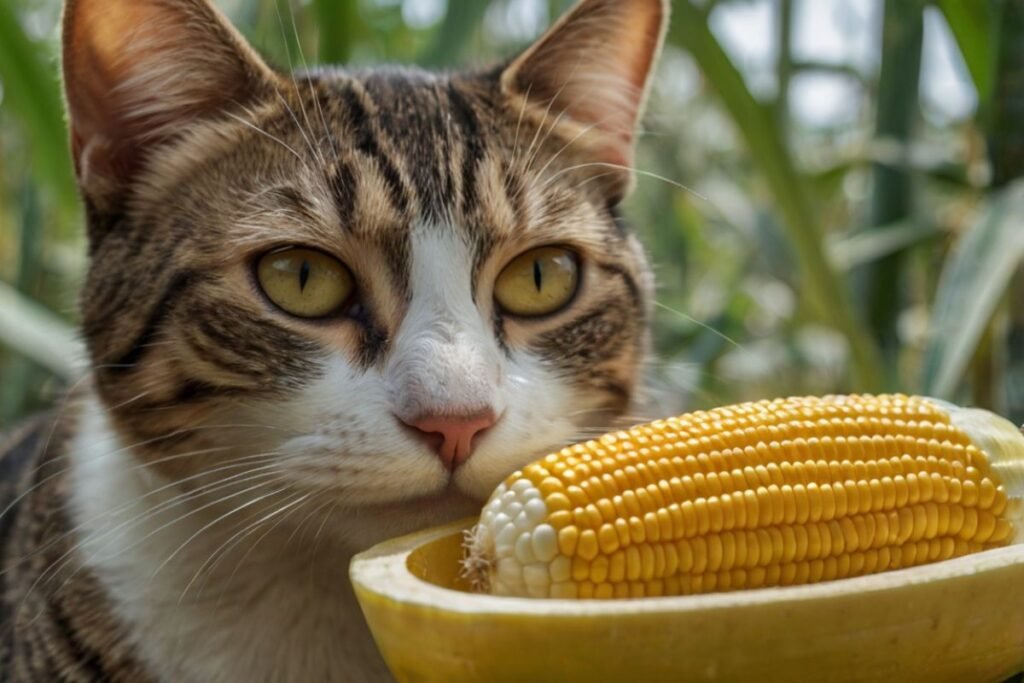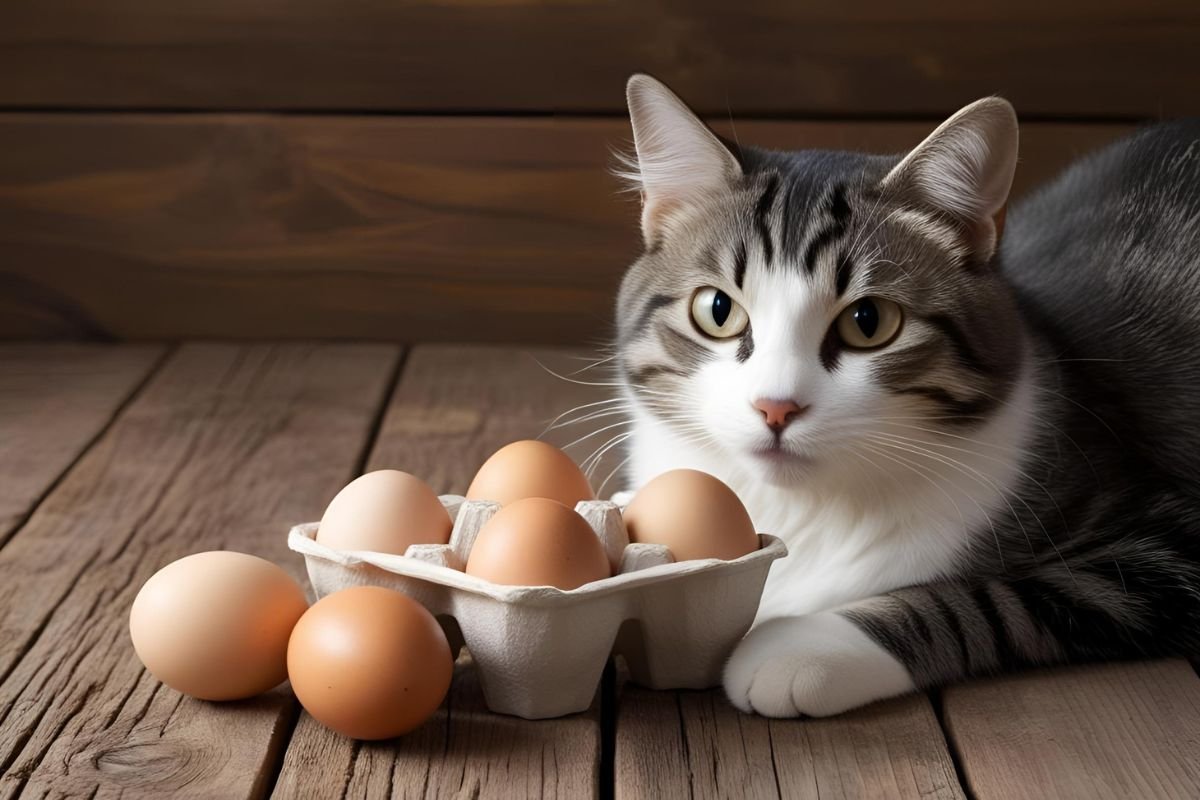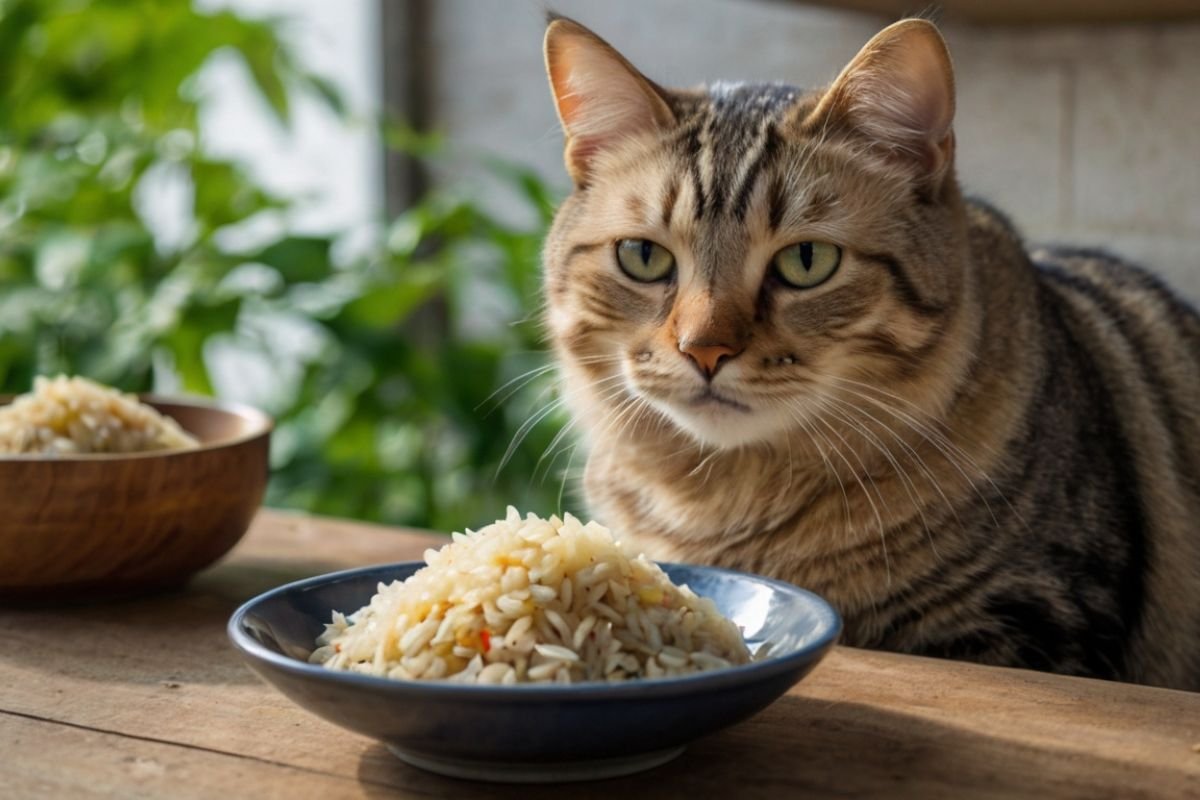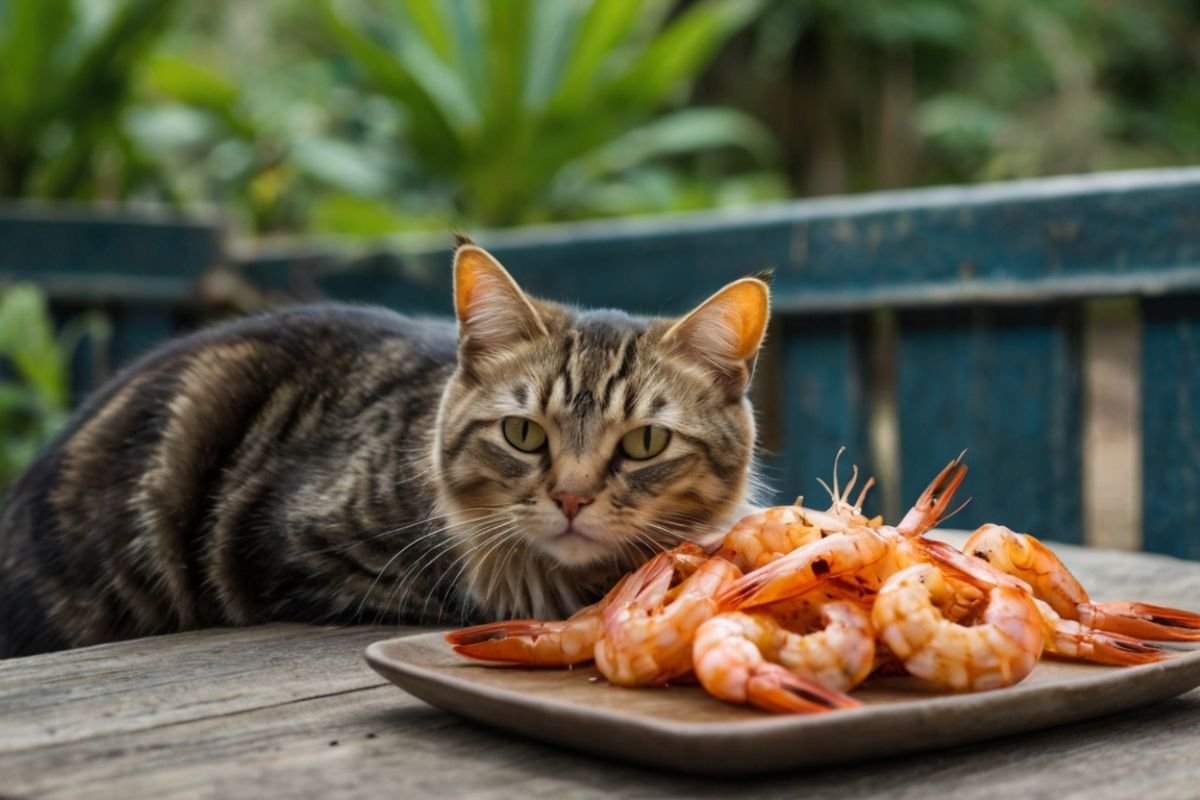Just last night, I was settling in with a plate of buttery corn on the cob when my orange tabby, Rio, hopped onto the counter. You know that look – those wide, innocent eyes that say, “Are you really going to eat ALL of that without sharing?” I bet your cat does it too. And in that moment, like so many cat parents before me, I wondered: is it actually okay to share this corn with my furry little friend?
I get it. We love our cats like family, and sharing food feels like sharing love. It’s one of those simple joys of pet parenthood – the delight in their excitement over a special treat. But our love also means making sure what we share is safe.
So let’s talk honestly about cats and corn – not as some cold scientific analysis, but as one cat lover to another. Let’s figure this out together.
Table of Contents
The Heart of the Matter: Cats and Corn

Before diving into all the details, here’s what you really need to know:
Corn isn’t toxic to our feline friends, but it’s not exactly on their natural menu either. Think of it like giving a vegetarian friend a tiny piece of tofu at a steakhouse – it won’t hurt them, but it’s not what their body is really craving.
Also read, Can Cats Eat Raw Chicken?
Understanding Our Cats: The Carnivores We Love
I’ve watched Rio stalk a toy mouse with the same intensity his wild ancestors must have hunted real prey. It’s a powerful reminder of something easy to forget when our cats are curled up purring on our laps: these sweet, domesticated companions are natural-born hunters at heart.
Cats are what scientists call “obligate carnivores.” In plain language? They’re meat eaters, through and through. Not by choice or preference, but by biological necessity. Their bodies are beautifully designed to thrive on animal protein.
Think about it – those sharp teeth aren’t made for grinding corn kernels. That relatively short digestive tract isn’t built to process lots of plant material. Even their metabolism is tuned to convert protein to energy, not carbs.
When Rio looks longingly at my corn, he’s not actually craving vegetables. He’s curious about what I’m enjoying so much, and he wants to be part of the experience. That’s the beautiful bond we share with our pets – they want to participate in our lives, even our meals.
What’s Really in Corn? And What Does Your Cat Really Need?
Corn is pretty amazing stuff for humans. It’s filled with carbohydrates for energy, some fiber, a handful of vitamins, and even a bit of protein. For thousands of years, corn has helped feed civilizations around the world.
But our cats? They’re wired differently.
Imagine if someone kept offering you food that your body couldn’t properly digest or use. That’s sort of what happens when we give cats food their bodies aren’t designed for.
What our feline friends truly need is:
- Rich, animal-based protein (much more than we do)
- Certain amino acids like taurine (which they can’t make themselves)
- Animal fats (not plant oils)
- Very specific vitamins and minerals
And what they don’t need much of? Carbohydrates – which happen to be corn’s main offering.
It’s not that corn is bad. It’s just not aligned with what makes our cats thrive.
The Possible Upsides of a Corn Nibble
Now, I’m not here to be the treat police. There’s joy in sharing safe foods with our pets in moderation. And corn does have a few minor potential benefits:
A small amount of fiber might help things move along if your cat is a bit constipated or dealing with hairballs. Though I’ve found that a quarter teaspoon of plain pumpkin works better for Rio when he needs help in that department.
The real benefit might just be the happiness factor. Remember how excited Rio was about trying my corn? That curiosity and stimulation is actually good for cats’ mental health. New tastes, textures, and smells enrich their environment.
And let’s be honest – there’s that heart-melting feeling we get when sharing something with our pets. That emotional connection matters too.
When Corn Might Not Be So Sweet: The Risks

As much as I want to give Rio everything his little heart desires, I’ve learned some hard lessons about the downsides of human foods for cats.
The Tummy Trouble
Have you ever dealt with a cat with diarrhea? Not fun for anyone involved. Cats simply don’t have the digestive enzymes to handle much plant matter.
Last summer, I gave Rio a bit too much corn from my salad. The poor little guy spent the next day uncomfortable with gas and loose stools. I felt terrible knowing I’d caused his discomfort. Now I’m much more careful.
The Allergy Angle
Some cats have food sensitivities we might not know about until they try something new. Corn is actually among the more common allergens for cats.
My friend’s cat Milo developed intense itching after having corn for the first time. She noticed him overgrooming until he had bald patches. Their vet confirmed a corn allergy, and now Milo eats a special corn-free diet.
Signs your cat might be allergic include:
- Excessive scratching or grooming
- Redness around the face or paws
- Ear infections
- Digestive upset
- Hair loss
Weight Worries
We all know the struggle to keep our pets at healthy weights. With over half of American cats overweight or obese, those extra corn calories can contribute to a problem that shortens our beloved pets’ lives.
Each kernel might seem tiny, but for a cat, it’s significant. A single tablespoon of corn might be 30 calories – when many cats only need 200-250 calories per day total!
The Danger Zone: What to Absolutely Avoid
Some corn-related items go beyond “not ideal” to potentially dangerous:
The corn cob is a serious hazard. If ingested, it can cause a life-threatening intestinal blockage requiring emergency surgery. Always dispose of corn cobs where curious cats can’t get them.
Anything on the corn matters too. Butter, salt, spices – all can upset their systems. And anything with garlic or onion (common in corn dishes) is toxic to cats.
Sharing Safely: How to Let Your Cat Try Corn
If your heart is set on letting your furry friend try corn, here’s how to make it as safe as possible:
First, start tiny – literally 1-2 kernels only. See how your cat’s digestion handles it before offering more.
Always serve plain, cooked corn with nothing added. No butter, no salt, no seasonings.
Make sure it’s cool enough not to burn sensitive mouths.
Remove completely from the cob and make sure pieces are small enough not to pose a choking risk.
Most importantly, make it an occasional special treat, not a regular part of their diet.
The Commercial Cat Food Corn Confusion
Walking down the pet food aisle can be overwhelming. Why is corn in so many cat foods if it’s not ideal for cats?
Honestly? Economics plays a big role. Corn is inexpensive compared to meat proteins. It helps bind kibble together and adds bulk at a lower cost.
Some vets will tell you small amounts of processed corn in quality cat food is perfectly fine for most cats. Others, especially those with more holistic approaches, advocate for grain-free or low-carb diets that better match cats’ natural nutritional needs.
I spent months researching food options when Rio developed some minor digestive issues. What I’ve come to believe is that while some cats tolerate corn in commercial foods just fine, others truly do better without it. Like so many things with our pets, it’s individual.
If your cat is healthy, active, and has a shiny coat on their current food, they’re probably doing fine. If you’re seeing issues like dull coat, excessive shedding, digestive problems, or weight gain, it might be worth trying a formula with different ingredients.
Different Corn Foods: Yes, No, or Maybe?
In my kitchen adventures with Rio watching hopefully nearby, I’ve wondered about various corn products. Here’s what I’ve learned:
Fresh corn kernels (plain and cooked): A few might be okay occasionally.
Canned corn: Only if well-rinsed to remove salt, and just a kernel or two.
Creamed corn: Definitely not – the dairy, salt, and sugar are too much.
Popcorn: Even plain popcorn can be a choking hazard, and most popcorn has butter and salt. Best avoided.
Cornbread: Too much fat, sugar, and other ingredients that aren’t cat-friendly.
Corn chips: Absolutely not – too much salt and fat, plus potentially harmful seasonings.
When in doubt, it’s always safer to stick with treats made specifically for cats.
When to Be Concerned: Warning Signs
Our cats can’t tell us when something isn’t sitting right, so we need to watch for signals. If you notice any of these after giving corn or any new food, it’s time to stop and possibly call the vet:
- Vomiting or diarrhea
- Lethargy or unusual behavior
- Excessive grooming, scratching, or hair loss
- Any signs of discomfort
Trust your instincts. You know your cat better than anyone, and if something seems off, it probably is.
Better Options to Share With Your Cat
If you’re looking to share some human foods with your cat (and I totally get that desire!), there are better options than corn:
Small bits of plain, cooked chicken or turkey are much closer to their natural diet.
Many cats love a little bit of plain, cooked pumpkin (not pie filling). It’s actually good for digestion issues.
A tiny amount of plain cooked carrot or green bean might be easier on their system than corn.
Remember that any treats – even perfect ones – should make up no more than 10% of your cat’s daily food intake.
Real Talk: My Journey With Rio and Human Foods
When Rio first came into my life as a tiny orange fluffball, I wanted to give him the world. He showed interest in everything I ate, and it was so tempting to share.
Over time, through trial and error (and yes, some unfortunate litter box situations), I’ve found what works for us. Rio gets high-quality cat food as his main diet. Occasionally – maybe once a week – he gets a tiny taste of something human-safe, like a bit of plain cooked chicken.
That one time with the corn? Lesson learned. Now if I’m eating corn and he shows interest, I might let him sniff it, but I don’t give him any. Instead, I keep some cat treats nearby and give him one of those instead. He’s just as happy, and his tummy stays happy too.
The look of joy on his little orange face when he gets his special treat is priceless. And knowing I’m keeping him healthy while still making him happy? That’s what being a good pet parent is all about.
The Heart of the Matter: Loving Our Cats Well
At the end of the day, this isn’t really about corn. It’s about how we show love to the animals who give us so much unconditional affection.
Sometimes the most loving choice isn’t giving them what they want in the moment, but what will keep them healthy and happy long-term. Just like we wouldn’t let a toddler eat candy for dinner despite their enthusiasm for the idea, we sometimes need to be the adults for our cats too.
The joy of sharing our lives with cats comes with the responsibility of making good choices for them. They trust us completely to take care of them.
So maybe instead of sharing our corn, we can show love by:
- Playing with an interactive toy for 10 minutes
- Giving a gentle brushing session
- Offering a cat-safe treat made for their bodies
- Creating a cozy new napping spot
- Just spending quality time together
I’ve found that Rio is just as excited about these forms of attention as he is about trying my food. What he really wants is the connection with me, not necessarily the corn itself.
From One Cat Parent to Another
If there’s one thing I’ve learned in my years with cats, it’s that each one is unique. What works perfectly for one cat might not work for another. Your cat might have zero interest in corn while another might beg for it.
The most important thing is to pay attention to your individual cat – their preferences, their needs, their reactions. Be willing to adjust as you learn together.
And when in doubt, have a chat with your vet. They know your cat’s specific health situation and can give tailored advice.
I’d love to hear about your experiences. Does your cat show interest in corn or other human foods? What safe treats have you found that your cat loves? We’re all in this together, learning how to be the best cat parents we can be.
Remember – every choice we make for our cats is an expression of our love for them. Even if that choice is saying “no” to sharing our corn on the cob.

Shahriar Robin is the creator of WhatPetsCanEat.com, a passionate pet lover and dedicated cat dad to Rio, a curious two-year-old orange feline who inspired this website. With a love for animals and a knack for research, Shahriar shares trusted, easy-to-understand information to help fellow pet owners make safe, healthy food choices for their furry friends.


